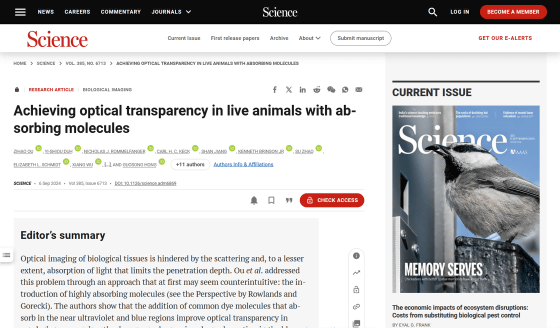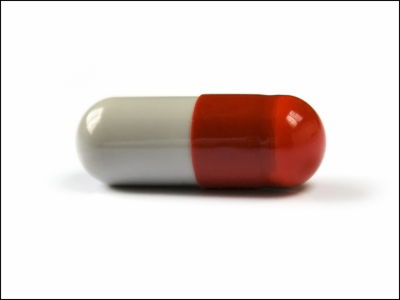A technology to make skin transparent and see internal organs by applying food coloring contained in snacks is developed

When you hear 'making skin transparent,' it may sound like an absurd science fiction or supernatural power. However, a research team at Stanford University has succeeded in developing a technology that makes the skin of a living mouse transparent and allows observation of the movement of its internal organs using food colorings commonly used in snacks and syrups.
Achieving optical transparency in live animals with absorbing molecules | Science

Researchers Create Solution That Makes Living Skin Transparent - News Center | The University of Texas at Dallas
https://news.utdallas.edu/science-technology/yellow-dye-solution-transparent-skin-2024/
Transparent mice made with light-absorbing dye reveal organs at work
https://www.nature.com/articles/d41586-024-02887-4
Scientists just made mice 'see-through' using food dye — and humans are next | Live Science
https://www.livescience.com/health/anatomy/scientists-just-made-mice-see-through-using-food-dye-and-humans-are-next
When light hits the boundary between two materials with different refractive indices , the light changes direction or is scattered, making the material appear opaque. The skin and muscles of many animals, including humans, are packed with various substances with different refractive indices, such as proteins, fats, and body fluids, so they do not allow light to pass through the skin.
A research team at Stanford University thought that by impregnating biological tissue with a dye that strongly absorbs light, it might be possible to fill the refractive index gap between the substances that make up the tissue, making it transparent.
The research team's idea is illustrated below. Normally, light that enters the skin is scattered due to the difference in refractive index of the various substances that make up the skin, so it is not possible to see underneath the skin. However, if the refractive index of the entire skin is made closer to a constant by adding a dye, the skin does not scatter and the contents appear transparent.

First, the team used theoretical physics to predict how certain molecules might change how light interacts with mouse tissue, and then narrowed down the list to a few candidates:
'When you dissolve tartrazine in water, the water bends light just like fat does,' said Guosong Hong , a co-author of the paper and an assistant professor of materials engineering at Stanford University. When tartrazine is added to tissues like skin, which contain water and lipids, the refractive index of the liquid component matches that of the fat, making the tissue appear transparent.
In fact, the research team applied tartrazine to thinly sliced raw chicken breast meat to see if it would become transparent. As a result, the letters underneath the breast meat were blurred before applying tartrazine, but after applying tartrazine, the letters became transparent and could be clearly seen.

The team then rubbed the tartrazine solution onto the scalp of a live mouse to see if it would become transparent. Once the dye had completely diffused into the skin, the mouse's scalp became transparent. The team reported that they could see the blood vessels running through the surface of the mouse's skull with a resolution of 0.001 millimeters.
In a similar experiment, the researchers performed a similar experiment on the abdomen of a mouse. Within minutes, the solution had penetrated the abdomen and clearly identified organs such as the liver, small intestine, and bladder. They could even see the muscles of the intestine contracting and the subtle movements of the organs as the heart beats.
If you click on the image below, the mosaic will be removed and you can see the photo of the 'internal organs visible through the transparent abdominal skin' observed by the research team. The photo is quite graphic, so please be careful when viewing it.

The method was reversible, and the skin transparency of the mice could be restored by rinsing the skin with water to remove the dye solution. Any excess tartrazine absorbed into the body was excreted in the urine within 48 hours of application. The team reported that application of the dye solution caused 'minimal irritation' in the short term, but had no long-term health effects.
'It's important that the dye is biocompatible, meaning it's safe for living organisms,' said Zihao Ou, a postdoctoral researcher at Stanford University at the time of the study and currently an assistant professor of physics at the University of Texas at Dallas. 'What's important is that the dye is very cheap and effective, and you don't need a lot of it.'
The method developed this time has not yet been tested on humans. Human skin is several times thicker than that of mice, making it difficult for tartrazine to be absorbed into the deeper layers. However, the research team hopes that if future research shows that the same method can be used in humans, it could become a useful medical tool.
Related Posts:
in Science, Posted by log1h_ik







